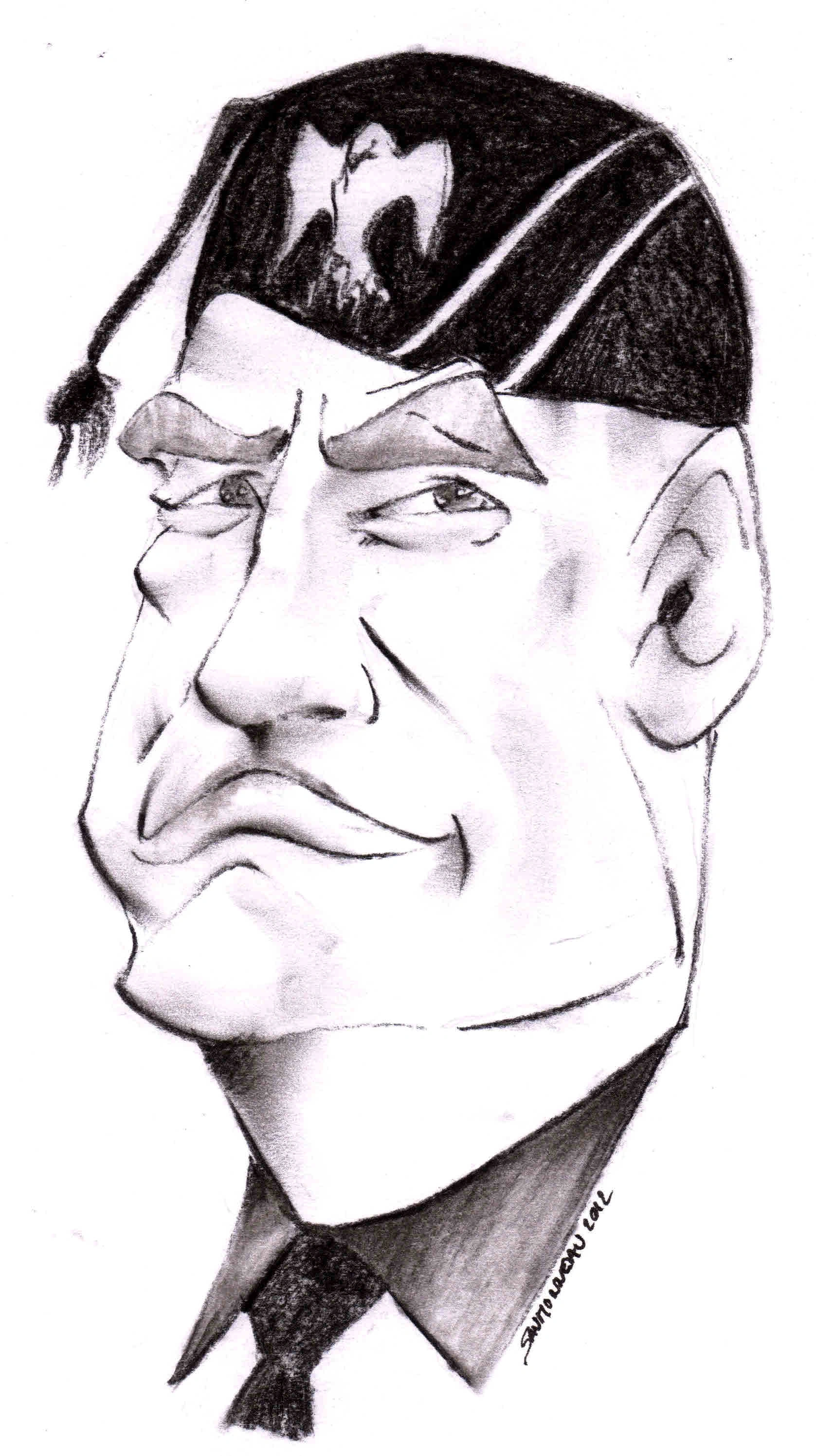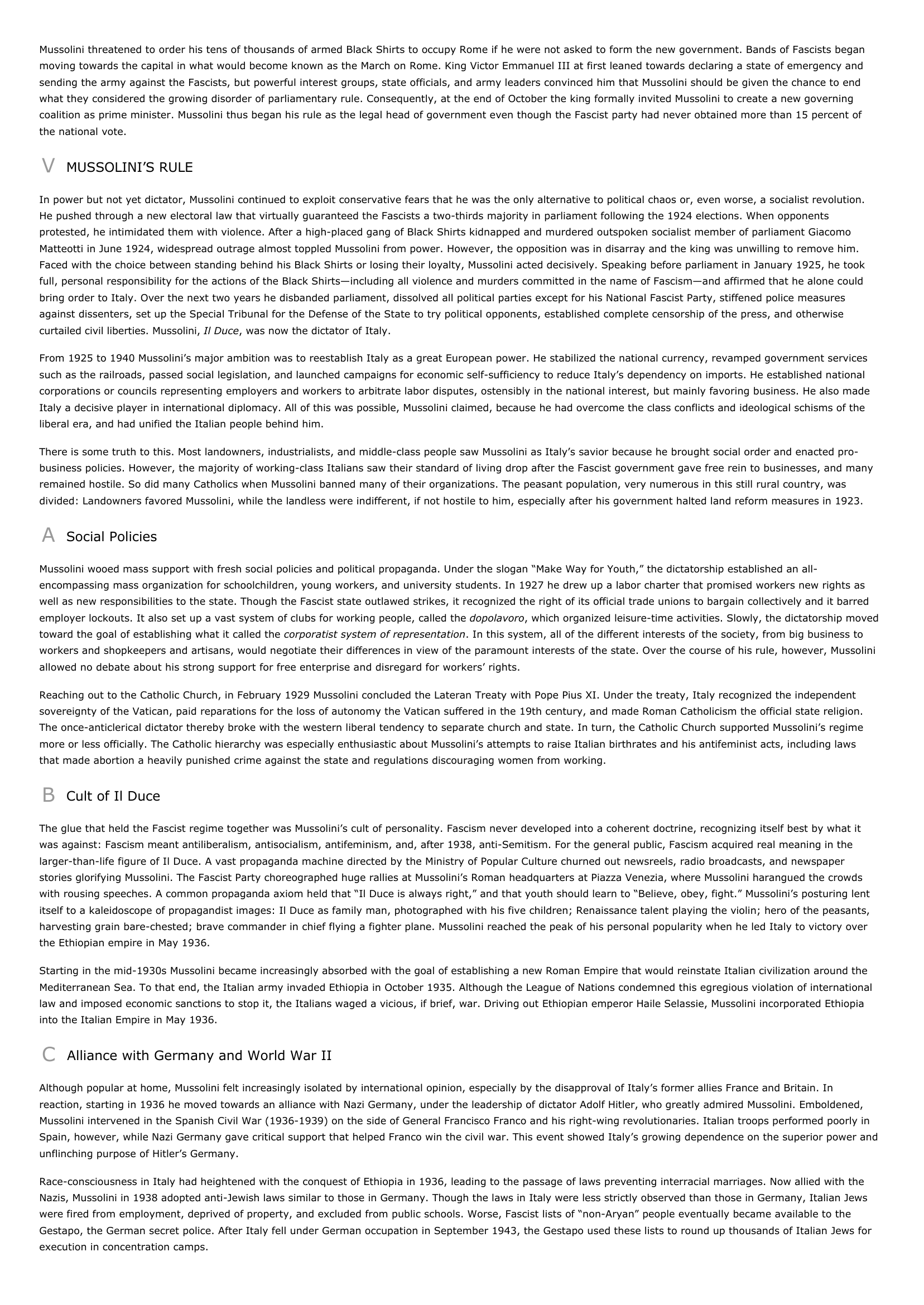Benito Mussolini.
Publié le 03/05/2013

Extrait du document


«
Mussolini threatened to order his tens of thousands of armed Black Shirts to occupy Rome if he were not asked to form the new government.
Bands of Fascists beganmoving towards the capital in what would become known as the March on Rome.
King Victor Emmanuel III at first leaned towards declaring a state of emergency andsending the army against the Fascists, but powerful interest groups, state officials, and army leaders convinced him that Mussolini should be given the chance to endwhat they considered the growing disorder of parliamentary rule.
Consequently, at the end of October the king formally invited Mussolini to create a new governingcoalition as prime minister.
Mussolini thus began his rule as the legal head of government even though the Fascist party had never obtained more than 15 percent ofthe national vote.
V MUSSOLINI’S RULE
In power but not yet dictator, Mussolini continued to exploit conservative fears that he was the only alternative to political chaos or, even worse, a socialist revolution.He pushed through a new electoral law that virtually guaranteed the Fascists a two-thirds majority in parliament following the 1924 elections.
When opponentsprotested, he intimidated them with violence.
After a high-placed gang of Black Shirts kidnapped and murdered outspoken socialist member of parliament GiacomoMatteotti in June 1924, widespread outrage almost toppled Mussolini from power.
However, the opposition was in disarray and the king was unwilling to remove him.Faced with the choice between standing behind his Black Shirts or losing their loyalty, Mussolini acted decisively.
Speaking before parliament in January 1925, he tookfull, personal responsibility for the actions of the Black Shirts—including all violence and murders committed in the name of Fascism—and affirmed that he alone couldbring order to Italy.
Over the next two years he disbanded parliament, dissolved all political parties except for his National Fascist Party, stiffened police measuresagainst dissenters, set up the Special Tribunal for the Defense of the State to try political opponents, established complete censorship of the press, and otherwisecurtailed civil liberties.
Mussolini, Il Duce , was now the dictator of Italy.
From 1925 to 1940 Mussolini’s major ambition was to reestablish Italy as a great European power.
He stabilized the national currency, revamped government servicessuch as the railroads, passed social legislation, and launched campaigns for economic self-sufficiency to reduce Italy’s dependency on imports.
He established nationalcorporations or councils representing employers and workers to arbitrate labor disputes, ostensibly in the national interest, but mainly favoring business.
He also madeItaly a decisive player in international diplomacy.
All of this was possible, Mussolini claimed, because he had overcome the class conflicts and ideological schisms of theliberal era, and had unified the Italian people behind him.
There is some truth to this.
Most landowners, industrialists, and middle-class people saw Mussolini as Italy’s savior because he brought social order and enacted pro-business policies.
However, the majority of working-class Italians saw their standard of living drop after the Fascist government gave free rein to businesses, and manyremained hostile.
So did many Catholics when Mussolini banned many of their organizations.
The peasant population, very numerous in this still rural country, wasdivided: Landowners favored Mussolini, while the landless were indifferent, if not hostile to him, especially after his government halted land reform measures in 1923.
A Social Policies
Mussolini wooed mass support with fresh social policies and political propaganda.
Under the slogan “Make Way for Youth,” the dictatorship established an all-encompassing mass organization for schoolchildren, young workers, and university students.
In 1927 he drew up a labor charter that promised workers new rights aswell as new responsibilities to the state.
Though the Fascist state outlawed strikes, it recognized the right of its official trade unions to bargain collectively and it barredemployer lockouts.
It also set up a vast system of clubs for working people, called the dopolavoro , which organized leisure-time activities.
Slowly, the dictatorship moved toward the goal of establishing what it called the corporatist system of representation .
In this system, all of the different interests of the society, from big business to workers and shopkeepers and artisans, would negotiate their differences in view of the paramount interests of the state.
Over the course of his rule, however, Mussoliniallowed no debate about his strong support for free enterprise and disregard for workers’ rights.
Reaching out to the Catholic Church, in February 1929 Mussolini concluded the Lateran Treaty with Pope Pius XI.
Under the treaty, Italy recognized the independentsovereignty of the Vatican, paid reparations for the loss of autonomy the Vatican suffered in the 19th century, and made Roman Catholicism the official state religion.The once-anticlerical dictator thereby broke with the western liberal tendency to separate church and state.
In turn, the Catholic Church supported Mussolini’s regimemore or less officially.
The Catholic hierarchy was especially enthusiastic about Mussolini’s attempts to raise Italian birthrates and his antifeminist acts, including lawsthat made abortion a heavily punished crime against the state and regulations discouraging women from working.
B Cult of Il Duce
The glue that held the Fascist regime together was Mussolini’s cult of personality.
Fascism never developed into a coherent doctrine, recognizing itself best by what itwas against: Fascism meant antiliberalism, antisocialism, antifeminism, and, after 1938, anti-Semitism.
For the general public, Fascism acquired real meaning in thelarger-than-life figure of Il Duce.
A vast propaganda machine directed by the Ministry of Popular Culture churned out newsreels, radio broadcasts, and newspaperstories glorifying Mussolini.
The Fascist Party choreographed huge rallies at Mussolini’s Roman headquarters at Piazza Venezia, where Mussolini harangued the crowdswith rousing speeches.
A common propaganda axiom held that “Il Duce is always right,” and that youth should learn to “Believe, obey, fight.” Mussolini’s posturing lentitself to a kaleidoscope of propagandist images: Il Duce as family man, photographed with his five children; Renaissance talent playing the violin; hero of the peasants,harvesting grain bare-chested; brave commander in chief flying a fighter plane.
Mussolini reached the peak of his personal popularity when he led Italy to victory overthe Ethiopian empire in May 1936.
Starting in the mid-1930s Mussolini became increasingly absorbed with the goal of establishing a new Roman Empire that would reinstate Italian civilization around theMediterranean Sea.
To that end, the Italian army invaded Ethiopia in October 1935.
Although the League of Nations condemned this egregious violation of internationallaw and imposed economic sanctions to stop it, the Italians waged a vicious, if brief, war.
Driving out Ethiopian emperor Haile Selassie, Mussolini incorporated Ethiopiainto the Italian Empire in May 1936.
C Alliance with Germany and World War II
Although popular at home, Mussolini felt increasingly isolated by international opinion, especially by the disapproval of Italy’s former allies France and Britain.
Inreaction, starting in 1936 he moved towards an alliance with Nazi Germany, under the leadership of dictator Adolf Hitler, who greatly admired Mussolini.
Emboldened,Mussolini intervened in the Spanish Civil War (1936-1939) on the side of General Francisco Franco and his right-wing revolutionaries.
Italian troops performed poorly inSpain, however, while Nazi Germany gave critical support that helped Franco win the civil war.
This event showed Italy’s growing dependence on the superior power andunflinching purpose of Hitler’s Germany.
Race-consciousness in Italy had heightened with the conquest of Ethiopia in 1936, leading to the passage of laws preventing interracial marriages.
Now allied with theNazis, Mussolini in 1938 adopted anti-Jewish laws similar to those in Germany.
Though the laws in Italy were less strictly observed than those in Germany, Italian Jewswere fired from employment, deprived of property, and excluded from public schools.
Worse, Fascist lists of “non-Aryan” people eventually became available to theGestapo, the German secret police.
After Italy fell under German occupation in September 1943, the Gestapo used these lists to round up thousands of Italian Jews forexecution in concentration camps..
»
↓↓↓ APERÇU DU DOCUMENT ↓↓↓
Liens utiles
- Zeittafel: Benito Mussolini.
- Benito Mussolini - Geschichte.
- Benito Mussolini par Roger Heacock Écrivain, Genève Il est aussi logique, bien que paradoxal, que l'Italie ait été le point de départ à la fois du nationalisme libéral et du fascisme contemporains.
- Benito Mussolini Fils de forgeron, Mussolini naquit en Romagne et débuta une carrière d'instituteur.
- Mussolini Benito, appelé il Duce (« le chef »), 1883-1945, né à Dovia di Predappio (Romagne), homme politique italien, chef du gouvernement de 1922 à 1943.



















